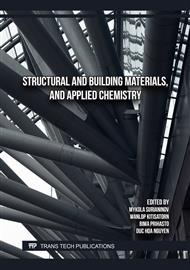[1]
Ming-Hung Tsai and Jien-Wei Yeh, High-Entropy Alloys: A Critical Review. Materials Research letters, 2014. 2: pp.107-123.
Google Scholar
[2]
George, E.P., D. Raabe, and R.O. Ritchie, High-entropy alloys. Nature Reviews Materials, 2019. 4(8): pp.515-534.
DOI: 10.1038/s41578-019-0121-4
Google Scholar
[3]
Li, Z., et al., Mechanical properties of high-entropy alloys with emphasis on face-centered cubic alloys. Progress in Materials Science, 2019. 102: pp.296-345.
DOI: 10.1016/j.pmatsci.2018.12.003
Google Scholar
[4]
Zhou, Y., et al., Solid solution alloys of AlCoCrFeNiTix with excellent room-temperature mechanical properties. Applied Physics Letters, 2007. 90: pp.181904-181904.
DOI: 10.1063/1.2734517
Google Scholar
[5]
Senkov, O.N., et al., Mechanical properties of Nb25Mo25Ta25W25 and V20Nb20Mo20Ta20W20 refractory high entropy alloys. Intermetallics, 2011. 19(5): pp.698-706.
DOI: 10.1016/j.intermet.2011.01.004
Google Scholar
[6]
Otto, F., et al., The influences of temperature and microstructure on the tensile properties of a CoCrFeMnNi high-entropy alloy. Acta Materialia, 2013. 61(15): pp.5743-5755.
DOI: 10.1016/j.actamat.2013.06.018
Google Scholar
[7]
Gludovatz, B., et al., A Fracture-Resistant High-Entropy Alloy for Cryogenic Applications. Science, 2014. 345: pp.1153-1158.
DOI: 10.1126/science.1254581
Google Scholar
[8]
Zhang, Y., et al., Microstructures and properties of high-entropy alloys. Progress in Materials Science, 2014. 61: pp.1-93.
Google Scholar
[9]
Lu, Z.P., et al., An assessment on the future development of high-entropy alloys: Summary from a recent workshop. Intermetallics, 2015. 66: pp.67-76.
DOI: 10.1016/j.intermet.2015.06.021
Google Scholar
[10]
Ye, Y.F., et al., High-entropy alloy: challenges and prospects. Materials Today, 2016. 19(6): pp.349-362.
Google Scholar
[11]
Yeh, J.W., et al., Nanostructured High-Entropy Alloys with Multiple Principal Elements: Novel Alloy Design Concepts and Outcomes. Advanced Engineering Materials, 2004. 6(5): pp.299-303.
DOI: 10.1002/adem.200300567
Google Scholar
[12]
Chen, M.-R., et al., Effect of vanadium addition on the microstructure, hardness, and wear resistance of Al0.5CoCrCuFeNi high-entropy alloy. Metallurgical and Materials Transactions A-physical Metallurgy and Materials Science - METALL MATER TRANS A, 2006. 37: pp.1363-1369.
DOI: 10.1007/s11661-006-0081-3
Google Scholar
[13]
Wang, Y., B. Li, and H. Fu, Solid Solution or Intermetallics in a High‐Entropy Alloy. Advanced Engineering Materials, 2009. 11: pp.641-644.
DOI: 10.1002/adem.200900057
Google Scholar
[14]
Chou, Y.L., J.W. Yeh, and H.C. Shih, The effect of molybdenum on the corrosion behaviour of the high-entropy alloys Co1.5CrFeNi1.5Ti0.5Mox in aqueous environments. Corrosion Science, 2010. 52(8): pp.2571-2581.
DOI: 10.1016/j.corsci.2010.04.004
Google Scholar
[15]
Chuang, M.-H., et al., Microstructure and wear behavior of AlxCo1.5CrFeNi1.5Tiy high-entropy alloys. Acta Materialia, 2011. 59(16): pp.6308-6317.
DOI: 10.1016/j.actamat.2011.06.041
Google Scholar
[16]
Singh, S., et al., Decomposition in multi-component AlCoCrCuFeNi high-entropy alloy. Acta Materialia, 2011. 59(1): pp.182-190.
DOI: 10.1016/j.actamat.2010.09.023
Google Scholar
[17]
Wang, W.-R., et al., Effects of Al addition on the microstructure and mechanical property of AlxCoCrFeNi high-entropy alloys. Intermetallics, 2012. 26: pp.44-51.
DOI: 10.1016/j.intermet.2012.03.005
Google Scholar
[18]
Otto, F., et al., Relative effects of enthalpy and entropy on the phase stability of equiatomic high-entropy alloys. Acta Materialia, 2013. 61(7): pp.2628-2638.
DOI: 10.1016/j.actamat.2013.01.042
Google Scholar
[19]
Shaysultanov, D.G., et al., Phase Composition and Superplastic Behavior of a Wrought AlCoCrCuFeNi High-Entropy Alloy. JOM, 2013. 65.
DOI: 10.1007/s11837-013-0754-5
Google Scholar
[20]
Yeh, J.-W., Alloy Design Strategies and Future Trends in High-Entropy Alloys. JOM, 2013. 65.
DOI: 10.1007/s11837-013-0761-6
Google Scholar
[21]
He, J.Y., et al., Effects of Al addition on structural evolution and tensile properties of the FeCoNiCrMn high-entropy alloy system. Acta Materialia, 2014. 62: pp.105-113.
DOI: 10.1016/j.actamat.2013.09.037
Google Scholar
[22]
Salishchev, G.A., et al., Effect of Mn and V on structure and mechanical properties of high-entropy alloys based on CoCrFeNi system. Journal of Alloys and Compounds, 2014. 591: pp.11-21.
DOI: 10.1016/j.jallcom.2013.12.210
Google Scholar
[23]
Suryanarayana, C., Mechanical Alloying: A Novel Technique to Synthesize Advanced Materials. Research (Wash D C), 2019. 2019: p.4219812.
DOI: 10.34133/2019/4219812
Google Scholar
[24]
Li, P., A. Wang, and C.T. Liu, Composition dependence of structure, physical and mechanical properties of FeCoNi(MnAl)x high entropy alloys. Intermetallics, 2017. 87: pp.21-26.
DOI: 10.1016/j.intermet.2017.04.007
Google Scholar
[25]
Bazioti, C., et al., Probing the structural evolution and its impact on magnetic properties of FeCoNi(AlMn)x high-entropy alloy at the nanoscale. Journal of Alloys and Compounds, 2022. 910: p.164724.
DOI: 10.1016/j.jallcom.2022.164724
Google Scholar
[26]
Hariharan, V.S., et al., Effect of Al addition and homogenization treatment on the magnetic properties of CoFeMnNi high-entropy alloy. Journal of Materials Science, 2020. 55: pp.1-14.
DOI: 10.1007/s10853-020-05171-8
Google Scholar
[27]
Li, Z., et al., Tuning phase constitution and magnetic properties by composition in FeCoNiAlMn high-entropy alloys. Journal of Alloys and Compounds, 2020. 845: p.156204.
DOI: 10.1016/j.jallcom.2020.156204
Google Scholar
[28]
Chen, C., et al., Effects of Al and Mn on microstructure, magnetic and mechanical properties of Fe40Co40Ni10M10 (M=Al, Mn) medium entropy alloys. Journal of Alloys and Compounds, 2022. 890: p.161779.
DOI: 10.1016/j.jallcom.2021.161779
Google Scholar
[29]
Yang, X. and Y. Zhang, Prediction of high-entropy stabilized solid-solution in multi-component alloys. Materials Chemistry and Physics, 2012. 132(2): pp.233-238.
DOI: 10.1016/j.matchemphys.2011.11.021
Google Scholar
[30]
Guo, S., et al., Effect of valence electron concentration on stability of fcc or bcc phase in high entropy alloys. Journal of Applied Physics, 2011. 109.
DOI: 10.1063/1.3587228
Google Scholar
[31]
Poletti, M.G., et al., Search for high entropy alloys in the X-NbTaTiZr systems (X=Al, Cr, V, Sn). Journal of Alloys and Compounds, 2015. 620: pp.283-288.
DOI: 10.1016/j.jallcom.2014.09.145
Google Scholar



